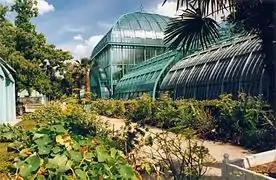

Auteuil (French pronunciation: [otœj]) is the westernmost quarter of Paris, France, located in the 16th arrondissement, on the Right Bank. It is adjacent to Passy to the northeast (administratively part of la Muette), Boulogne-Billancourt to the southwest, and the Bois de Boulogne to the northwest.
History

Auteuil was originally a hamlet named Attolium[1] on the outskirts of Paris, built between the thirteenth and seventeenth centuries; it became a fashionable country retreat for French elites during the reign of Louis XV. Passy was dependent on the parish of Auteuil until 1761.[2] After the French Revolution, Auteuil became a commune of Seine. It was absorbed into Paris along with several other communities in 1860.[3]
Auteuil was incorporated into the city of Paris in 1859–60 by the Law of 16 June 1859. At that time, it was planned that Auteuil and Passy would form a new arrondissement that would be numbered the 13th arrondissement, but "The rich and powerful moving in did not like the number. They pulled strings and became the 16th, the unlucky association and postmark being transferred to the blameless but less influential folks around Porte d'Italie."[4]
Landmarks
Among the landmarks of Auteuil are Notre-Dame d'Auteuil, the Jardin des Serres d'Auteuil and the Pavillon de l'eau.
 Notre-Dame d'Auteuil
Notre-Dame d'Auteuil The Jardin des Serres d'Auteuil
The Jardin des Serres d'Auteuil The Pavillon de l'eau
The Pavillon de l'eau
Sport
Auteuil is known for its famous stadiums:
- Stade Roland Garros where the tennis French Open is played
- Parc des Princes which is the home of football club Paris Saint-Germain
- Stade Jean-Bouin which is the home of rugby club Stade Français
- Auteuil Hippodrome where steeplechase races are held
- Piscine Molitor, an art deco swimming pool protected as national heritage site
 Stade Rolland Garros
Stade Rolland Garros Parc des Princes
Parc des Princes Stade Jean Bouin near Parc des Princes
Stade Jean Bouin near Parc des Princes Auteuil Hippodrome
Auteuil Hippodrome Piscine Molitor
Piscine Molitor
Education
Auteuil is home to the Lycée Jean-Baptiste-Say operating as a collège, lycée and preparatory classes.
Notable people
The borough of Auteuil was the birthplace of Marcel Proust and of Charles Baudelaire.[5][6] It was also the home of Molière.[7]
Thérèse Anaïs Rigo, better known by her pseudonym Anaïs de Bassanville, a journalist, was born in 1802 in Auteuil and died there in 1884.
In popular culture
In The Count of Monte Cristo by Alexandre Dumas, the main (fictional) character Edmond Dantès buys his country residence in Auteuil.
References
- ↑ Paris Guide. p. 1232.
- ↑ Paris. 1861. p. 422.
- ↑ Carmona, Michel (2002). Haussmann: His Life and Times, and the Making of Modern Paris. Chicago: Ivan R. Dee. pp. 320–2.
- ↑ "For Parisians, It's Sweet in the Sixteenth". New York Times.
- ↑ "The Discreet Charm of Passy-Auteuil". New York Times.
- ↑ "Biography". Proust-Ink.
- ↑ "A Tranquil Village in the City". Bonjour Paris.